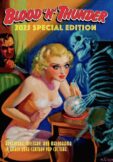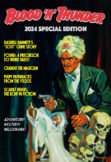EDitorial Comments
Birthday Boy: Elmo Lincoln
The first actor to play Edgar Rice Burroughs’ Tarzan of the Apes in a motion picture was born on this day in 1889 in Rochester, Indiana. Otto Elmo Linkenheit was a burly youth when he left his middle-class home for California. He held several jobs (including one as a longshoreman, where his prodigious strength was a decided asset) before breaking into silent films as an actor. Initially billed as Lincoln Helt, he became a protégé of prominent director D. W. Griffith, who cast him in The Battle of Elderbush Gulch (1913). Elmo got progressively better roles from Griffith in the director’s classic feature films Judith of Bethulia (1914), The Birth of a Nation (1915), and Intolerance (1916). Reportedly, Griffith was the one who persuaded the Indiana native to make Elmo Lincoln his stage name.
Elmo worked steadily over the next several years, eventually becoming a leading man in Might and the Man (1917). He owed his casting as ERB’s immortal Ape Man to a fluke. Producer William Parsons had originally cast an actor named Winslow Wilson to play the title role in his film adaptation of Tarzan of the Apes, which went before the cameras in the summer of 1917. At that time an ensign in the U.S. Naval Reserve, Wilson was called to active duty a few weeks after production began. Parsons was forced to suspend principal photography and resume casting in Los Angeles. Elmo’s massive physique and substantial acting experience made him the obvious choice. There was one catch: He was afraid of heights and looked unaccountably timid in sequences calling for him to climb trees and swing from vines. Fortunately, Winslow Wilson had already shot most of the “aerial” scenes needed and Parsons elected to keep his previous star’s vine-swinging footage in the picture.
Edgar Rice Burroughs felt—correctly—that the bulky Lincoln did not accurately represent the lithe, sinewy Ape Man of his popular stories. But Elmo’s imposing appearance and obvious strength made him convincing in scenes where raw power was called for, such as his wrestling match with a lion. And although ERB squabbled with Parsons repeatedly, he wanted the picture to be a success and publicly lent his support to the venture, posing with Lincoln for publicity photos.
Tarzan of the Apes, many months in production, was a sensation upon its premiere in January 1918. The original version was ten reels in length, with a running time of more than two hours. Parsons trimmed the footage by 20 percent and sent the picture into national release that April. Its success made Elmo Lincoln a star. He reprised the role later that year in a hastily turned out sequel, The Romance of Tarzan, undertaken by Parsons as soon as it became apparent that the first picture was a big hit. (Tarzan of the Apes is said to have grossed more than a million dollars, this at a time when movie theaters charged 10 to 25 cents per ticket.)
The following year Elmo was signed to an exclusive contract by the Great Western Producing Company, whose principals, Julius and Abe Stern, were related by marriage to Carl Laemmle, president of what was then called the Universal Film Manufacturing Company. Lincoln starred in three cliffhanger serials produced by Great Western and released by Universal: Elmo the Mighty (1919), Elmo the Fearless and The Flaming Disc (both 1920). Packed with action, these episodic thrills included frequent scenes of the star getting his shirt ripped off so audiences could see his barrel chest.
When the Weiss brothers-owned Numa Pictures Corporation, which had licensed screen rights to ERB’s The Return of Tarzan, decided to make a serial out of the book, Great Western was contracted to produce the chapter play with Lincoln reprising his star-making role. Enid Markey had played Jane in the first two features but was replaced by younger, prettier Louise Lorraine in the serial, which was titled The Adventures of Tarzan. A hectic, action-packed affair, it reached the nation’s screens in December 1921 and was quite profitable, although not as much as Tarzan of the Apes had been.
For reasons still not easily determined, Elmo’s career virtually dissolved in the years after Adventures of Tarzan. By 1923 he was reduced to playing an unbilled supporting role in The Hunchback of Notre Dame with Lon Chaney. He appeared in just a handful of bit parts before securing his last leading role, in the 1927 Rayart serial King of the Jungle. Despite the title, it was not a Tarzan picture; Lincoln played a Great White Hunter type. King was a modest success but did nothing to reverse Elmo’s steady decline. Subsequently he left Hollywood to pursue several business ventures.
Lincoln returned to motion pictures in 1939, making frequent appearance in “B” Westerns starring the likes of Gene Autry, George O’Brien, and Charles Starrett. Ironically, he also won small roles in a brace of later films featuring ERB’s Ape Man: Tarzan’s New York Adventure (1942, starring Johnny Weissmuller) and Tarzan’s Magic Fountain (1949, starring Lex Barker). Publicity materials for both movies played up Elmo’s association with the character.
The screen’s first Tarzan died on June 27, 1952, at the age of 63. He had a heart attack in the middle of a coughing spell.
Recent Posts
- Windy City Film Program: Day Two
- Windy City Pulp Show: Film Program
- Now Available: When Dracula Met Frankenstein
- Collectibles Section Update
- Mark Halegua (1953-2020), R.I.P.
Archives
- March 2023
- July 2021
- May 2021
- March 2020
- February 2020
- December 2019
- November 2019
- October 2019
- September 2019
- August 2019
- May 2019
- April 2019
- March 2019
- February 2019
- December 2018
- November 2018
- October 2018
- August 2018
- June 2018
- February 2018
- December 2017
- October 2017
- September 2017
- August 2017
- May 2017
- April 2017
- February 2017
- September 2016
- August 2016
- July 2016
- June 2016
- November 2015
- October 2015
- September 2015
- August 2015
- July 2015
- June 2015
- May 2015
- April 2015
- March 2015
- February 2015
- January 2015
- August 2014
- July 2014
- June 2014
- May 2014
- April 2014
- January 2014
- December 2013
- September 2013
- August 2013
- July 2013
- June 2013
- May 2013
- April 2013
- March 2013
- February 2013
- January 2013
- December 2012
- October 2012
- September 2012
- August 2012
- July 2012
- June 2012
- May 2012
Categories
- Birthday
- Blood 'n' Thunder
- Blood 'n' Thunder Presents
- Classic Pulp Reprints
- Collectibles For Sale
- Conventions
- Dime Novels
- Film Program
- Forgotten Classics of Pulp Fiction
- Movies
- Murania Press
- Pulp People
- PulpFest
- Pulps
- Reading Room
- Recently Read
- Serials
- Special Events
- Special Sale
- The Johnston McCulley Collection
- Uncategorized
- Upcoming Books
- Western Movies
- Windy City pulp convention
Dealers
Events
Publishers
Resources
- Coming Attractions
- Field Guide to Wild American Pulp Artists
- MagazineArt.Org
- Mystery*File
- ThePulp.Net








